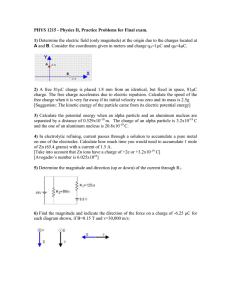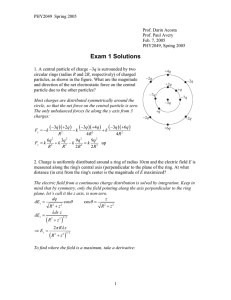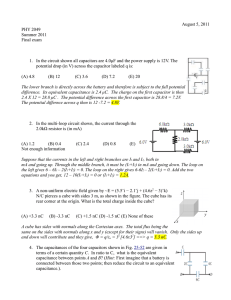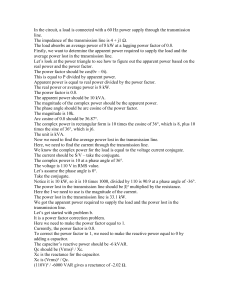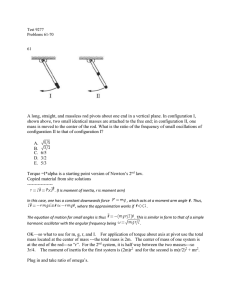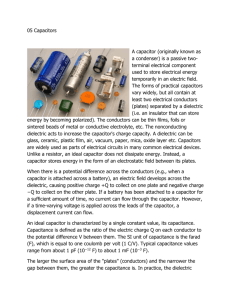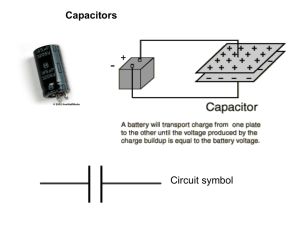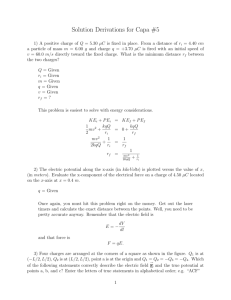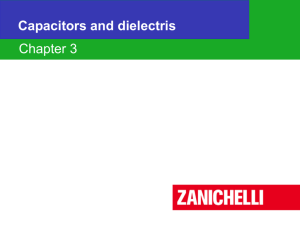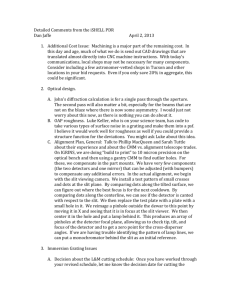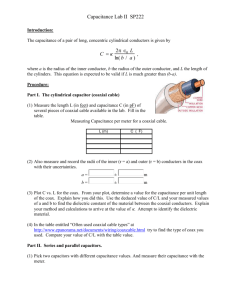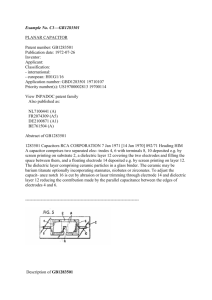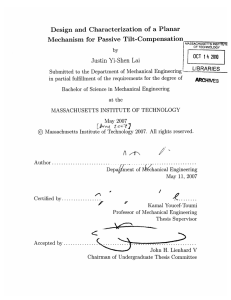Phys 1115, First Quiz August 28th 2006
advertisement
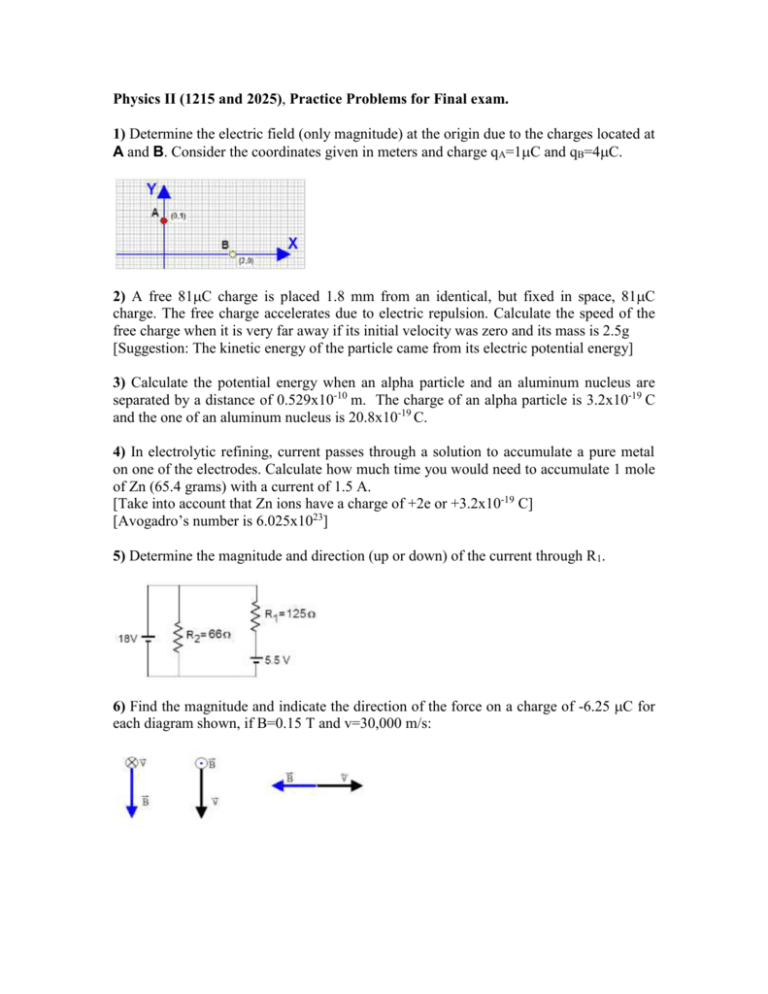
Physics II (1215 and 2025), Practice Problems for Final exam. 1) Determine the electric field (only magnitude) at the origin due to the charges located at A and B. Consider the coordinates given in meters and charge qA=1C and qB=4C. 2) A free 81C charge is placed 1.8 mm from an identical, but fixed in space, 81C charge. The free charge accelerates due to electric repulsion. Calculate the speed of the free charge when it is very far away if its initial velocity was zero and its mass is 2.5g [Suggestion: The kinetic energy of the particle came from its electric potential energy] 3) Calculate the potential energy when an alpha particle and an aluminum nucleus are separated by a distance of 0.529x10-10 m. The charge of an alpha particle is 3.2x10-19 C and the one of an aluminum nucleus is 20.8x10-19 C. 4) In electrolytic refining, current passes through a solution to accumulate a pure metal on one of the electrodes. Calculate how much time you would need to accumulate 1 mole of Zn (65.4 grams) with a current of 1.5 A. [Take into account that Zn ions have a charge of +2e or +3.2x10-19 C] [Avogadro’s number is 6.025x1023] 5) Determine the magnitude and direction (up or down) of the current through R1. 6) Find the magnitude and indicate the direction of the force on a charge of -6.25 C for each diagram shown, if B=0.15 T and v=30,000 m/s: 7) What will be the direction of the current induced in the small circular loop when the switch “S” is suddenly opened? 8) Sketch the intensity of light observed in the single-slit experiment. D is the width of the slit, the light wavelength is λ and sin(θ) is the sine of the deflected angle. 9) Alice is nearsighted with a far point of 25cm (she cannot see clearly beyond this point). What kind of glasses and of what power does she need to see distant objects clearly? [Neglect eye-lens distance]. 10) A cardiac defibrillator is used to shock a heart that is beating erratically. A capacitor in the device is charged to 3kV and stores 900J of energy. What is its capacitance? 11) The fuses in the multimeters that we use in the lab are rated 315mA. Calculate the minimum resistance that we need to connect in series with a voltage source of 5 volts if we don’t want to blow the fuse. Consider the internal resistance of the instrument to be 1.5 Ω when used as an ammeter. 12) The switch in the figure has been closed for a long time, so the capacitor is charged to 30 volts. Then at time t=0 you open the switch and the voltage starts dropping (the multimeter behaves as a resistance of 10MΩ) find how long it takes for the voltage in the capacitor to get to 4.06V. 13) A typical cell phone antenna is designed so it is ¼ of the wavelength of the carrier signal. Calculate the length of the antenna for a cell phone operating at 1.9GHz. 14) In order for fiber optics to reflect light inside the medium, the angle of incidence on the glass-sheath interface (shown in the figure as Φ) must be greater than 50º. Based on this, calculate the maximum angle θ for incident light that will be reflected internally. [Index of refraction of glass = 1.52] 15) A headlamp in a car is rated 55W at 12V, which means that it uses 55 Joules per second and in turn it means that a charge of -4.6C goes through the lamp every second. How many electrons go through the lamp per second? 16) Calculate the electric force between an alpha particle and an aluminum nucleus separated by a distance of 0.5x10-10 m. 17) Find the acceleration experienced by an electron in an electric field of 250 N/C. 19) Determine the magnitude of the electric field at the origin due to the two charges “A” and “B”. Consider the positions given in meters and charge of A=30C and B=-30C. 20) An 18C charge is placed 1.8 m from an identical 18C charge. Calculate the electric field and the electric potential at the point midway between them 21) If it weren’t for practical reasons that prevent it, water would be a good choice to make capacitors since its dielectric constant is very large (Kwater=81). Calculate the capacitance (in Farads) of two plates submerged in water if their area is 1.55 m2 and the distance between them is 0.25 mm. 22) A cardiac defibrillator is used to shock a heart that is beating erratically. A capacitor in this device is charged to 3.5 kV and stores 800 J of energy. What is the capacitance? 23) Determine the electric potential at the origin due to the charges located at A and B. Consider the coordinates given in meters and charge qA=-2C and qB=-1C. 24) Calculate the capacitance of the two plates shown in the figure when they are completely submerged in a liquid whose dielectric constant (K) is 3.4. Area of the plates=0.24 m2, distance between the plates = 0.36 mm. [Dielectric permittivity of vacuum, o 8.85 x10 12 F / m ] 25) In electrolytic refining, current passes through a solution to accumulate a pure metal on one of the electrodes. Calculate how much time you would need to accumulate 1 mole of copper with a current of 5.5 A. [Charge of one Cu+ ion = 1.6x10-19 C, 1 mole of atoms = 6.022x1023 atoms] 26) Indicate if the following quantities are vectors or scalars and the units used to measure them: (i) Electric potential: Vector or scalar? ________ Units?__________ (ii) Electric field Vector or scalar? ________ Units?__________ (iii) Magnetic field Vector or scalar? ________ Units?__________ 27) If two adjacent parallel wires carry electric current in the same direction, are they attracted to each other or repelled from each other? Give a short explanation. 28) The particle shown in the figure enters a region of magnetic field and is deflected upward. Is the charge of the particle positive or negative? Explain. 29) Find the magnetic field at point “P” produced by the two long straight current carrying wires shown in the figure: 30) The figure shows the actual position of a fish in a tank. Indicate the approximate position of the fish image as seen by the eye in the following figure: 31) A laser beam coming from a submarine exits the water at an angle of 33º to the vertical. What is the angle of incidence of the beam when it hits the air-water interface? [nwater = 1.33] 32) Alice is nearsighted with a far point of 25cm (she cannot see clearly beyond this point). What kind of glasses and of what power does she need to see distant objects clearly? [Neglect eye-lens distance in this problem]. 33) Polarization. Find how much intensity of a beam of un-polarized light will go through three polarizers, where the first and second are rotated 37º with respect to each other and the second and third are also rotated 37º with respect to each other 34) Wave nature of light, interference. A diffraction grating is used to determine wavelengths in a spectrometer. Calculate the angular separation (in degrees) between the two main lines of sodium (589.0 nm and 589.6 nm) if the grating has a density of 15,000 lines per inch. [1 inch = 2.54cm] 35) Interference pattern. What happens to the interference pattern of double slits when you reduce the distance between the slits? [Suggestion: Draw a diagram] 36) A diffraction grating has lines separated by 3.5μm. Calculate the angle of diffraction of the first order fringe for green light (λ=530nm) and red light (λ=650nm) 37) Glass prisms disperse light, separating white light in colors. How do you explain this in terms of index of refraction? And, what color is deflected more, red or blue? 38) What is the minimum angular separation between two stars that can be resolved with one of the Keck telescopes in Hawaii. Consider the diameter of the telescope to be 10 m and the wavelength of the light 550nm.
